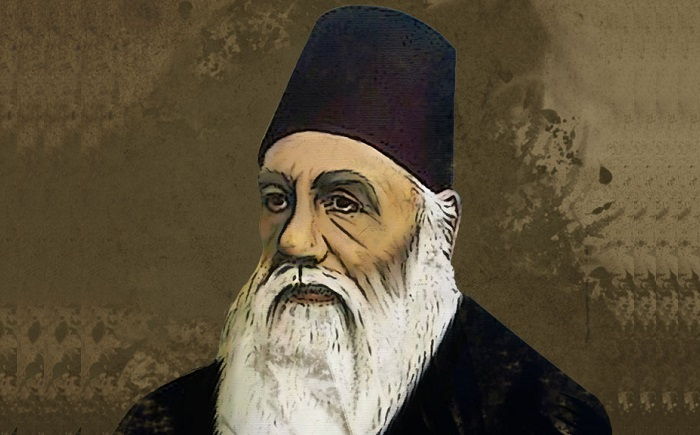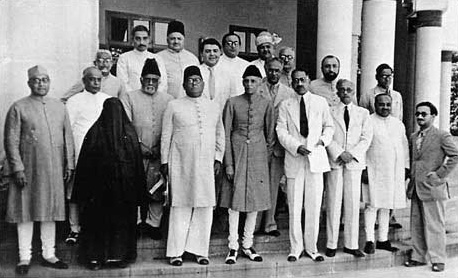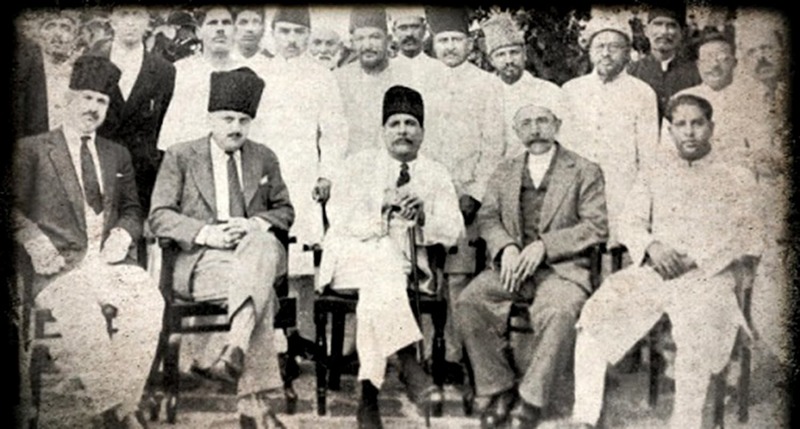Around the middle of the 19th Century when the spirit of nationalism was becoming visible among western educated, Indian middle class. At the same time, a separatist movement also started raising his head in India. Separatism as well as nationalism was the work of the middle class. Gradually this separatist movement based on cultural identity got transformed into a movement for a separate state.
In spite, the fact Hindus & Muslims fought together against British Rule during the revolt of 1857, separatist tendencies had started becoming soon after. It was the movement separate state launched by these separatist forces that made India bear the pain of partition along with joy for Independence.
Muslim Separatist Movement
The larger background of the separatist movement of India could be traced to offers made by sections of Muslim intellectual like Abdul Latif, Sayyad Amit Ali, Sayyad Amit Hussain, and Sayyad Ahmad Khan. By the middle of the 19th Century, Hindu society had progressed quite significantly because of the effect of the Hindu Socio reform movements.
These reform movements laid by leaders like Raja Rammohan Roy, Debendranath Tagore Keshavchandra Sen were liberal & progressive. These reformers strongly supported the spread of western education as a result of which Hindus could enter government services & they could absorb the liberal and progressive ideas of the enlightenment.
While the impact of the Hindu socio-reform movement was the impact of the Muslim socio-reform movement was negative in Muslim society. The Muslim socio-reform movement was background looking. These movements like the “Wahabi Movement.” of Sayyad Ahmad of Raibareli, “Ahmadi Movement” of Mirza Gulam Ahmad emphasizing restoring purify of Islam. They opposed western educations & western ideas.
As a result of the background looking character of the Muslims socio-religious reform movement, Muslim society couldn’t merge ahead on the path of modernity, and Muslims remained trapped in backwardness. By the middle of the 19th Century, the socio-economic difference between Muslim-Hindu was quite contrasting & to bridge this difference, the leader like Abdul Latif & Sayyad Ahmad Khan made efforts.
Anjuman-i-Islamia was established as 1st organization by a group of Muslim intellectuals in 1855 to spread western education among Muslims. Mohammedan-literally & scientific society was established by Abdul Latif in 1863. In 1864, Sayyad Ahmad Khan established the Science Society also known as translation society so that English works could be translated into Urdu & Persian for use of Muslims. In 1870, Sayyad Ahmad Khan started publications of “Tahzib-ul-Akhlaq” in Urdu to propagate his idea among Muslims.
Mohammedan Anglo-Oriental College was established at Aligarh in 1875 to spread modern education among Muslims. In 1877, National Mohammedan Association was established at Calcutta by Sayyad Amir Ali & Sayyad Amir Hussain. There was nothing Anti-Hindu in act of Muslim intellectuals. The communal outlook was absent in their activities but since the Hindus were taken as a reform to measure progress, the spirit of competition entered into activities of Muslim intellectual gradually. This paved way for the emergence & growth of the Muslim separatist movement later on.
Emergency of Separation
The Foundation of Congress in Dec 1885 resulted at the beginning of the Indian National Movement. By 1888, the real nationalist character of Congress came out in open. The nationalist pressure on British colonial rule forced the British to give a new orientation to their policy of divide and rule.
Muslim separatism & growth of communal outlook among Muslims were the outcomes of the same. Muslim intellectuals like Sayyad Ahmad Khan were convinced that demands of Congress for a democratic political system were against Muslim interest because in democracy majority rules.
Since Muslims were in a minority in India. It was emphasized that in a democratic political system Muslims would be left at mercy of Hindu forever. This British politics of “divide and rule” produced the desired effect. The leaders like Sayyad Ahmad Khan lost his faith inefficacy of Hindu-Muslim unity & they became communal.

By 1888, Sayyad Ahmad Khan had got transformed into a communal leader, while speaking at Meerut in 1888 he commented that Hindu & Muslim were two varying communal & they can never live together peacefully. “United India Patriotic Association” was founded by Syed Ahmad Khan in 1888 to counter the growing influence of Congress. In 1893, the “Mohammedan Anglo-Oriental defense Association” was founded by him to organize radical propaganda against Congress.
Partition of Bengal was carried out British to strengthen communal forces & widen the gulf between Hindu & Muslim. By creating a new Muslim majority province of East Bengal British wanted to convince that they were their true savior. Partition of Bengal was welcomed by Muslim communal leaders like Nawab Wakar-ul-Mulk, Mohsin-u-Mulk, and Aga Khan. They celebrated the implementation of partition & the 1st anniversary of Partition of Bengal was celebrated by them as the day of rejoicing. The Foundation of the Muslim League was blessed by the British Rule.
On 1st Oct 1906, a delegation of 35 Muslim leaders met government general Minto-II at Shimla to take his blessing. The league came into existence in Dec 1906. Grant of Separatist electorate to Muslim in 1909 through Minto-Morle reform was another British initiative to strengthen communal forces. Condemnation to separatist of the electorate by Congress also added fuel to fire of separatist. Sudhi & Sangathan movement organized by radical Hindu elements added further fuel to separatists in India.
Emergency of Movement

The outcome of the general election of 1937 and developments that followed transformed the Muslim cultural movement into a movement for a separate state revolving idea around “Pakistan”. The idea of a separate state was put forward for 1st time by two brothers named Abdul Sattar and Abdul Jabbar. They were communist leaders, they went to Moscow to attained 2nd CI (Communist International), WWGC (World Wide gathering of a communist) (1916) and here they demanded a separate State for Muslims.
In 1924, Lala Lajpat Rai put forward the view that Muslims should be divided into separate states into religious lines. In 1930, at the Allahabad session of Muslim League, Md. Iqbal put forward the view that the creation of an autonomous unit in the North-Western Region of the Indian Subcontinent would be in the larger interest of the Muslim League.
In 1933, Choudhry Rahmat Ali was an undergraduate student in Cambridge belonging to Punjab coined the term “PAKISTAN”. He was expecting that Iqbal would raise the demand for a separate state in the Round Table conference and where Iqbal was failed to do so, Rahmat Ali felt hurt. He published a pamphlet titled “now or never” and in this, he used termed Pakistan for 1st time.

The word Pakistan is made by letter taken from Muslim majority provinces. He started the Pakistan National Movement to propagate the idea. Munistan (Bengal), Usministan (Hyderabad). Before 1937, the idea of a separate state was not supported by any prominent leader or party in India. When Mohammad Ali Jinnah heard that Pakistan was demanded by Rahmat Ali, he had commented that Rahmat Ali was a kid and he was not aware of the realities of India.
General Election of 1937 and the Emergence of Demand of Separate State
The emergence of a separate state was a response & reaction to the development that followed the general election of 1937. In this election, Congress was highly successful as it could win a majority in six provinces. It was a big party in North West Frontier Province & Assam. In these provinces, Congress formed a coalition government (8/11).
On other hand, the Muslim League was a miserable failure. It couldn’t win a majority in any of the provinces. The league couldn’t even open its account in Bihar, Central Province, Sindh, and Odisha. Other Muslim parties such as the “Unionist Party” of Sikander Hayat Khan (Formed Government in Punjab), “United Sindh Party” of Allahabad, and “Krishak Praja Party” of Fazal-ul-Haq (Bengal) were highly successful.
In the election of 1937, Congress and Muslim League enjoyed a secrete understanding, their manifestos were similar & leaders were conscious not to attack each other during elections. Both parties reached an understanding that irrespective of the outcome of the election, they will form a government together.
The outcome of the election turned these parties away. As the politics of the Muslim League was badly rejected by people, Congress didn’t invite Muslim League to join the ministries because such an invitation would have been an insult to electorates. Muhammad Ali Jinnah wrote several letters to Congress leaders and Gandhiji but they stacked to the ground and refused to invite the Muslim league for joining ministries.
Analysis of the outcome of elections revealed that Congress didn’t receive much support from the poor section of the Muslim peasantry. To overcome this limitation, Congress decided to launch a mass contact program. This was a step in the right direction but it antagonized Muslim League as comparatively poor Muslim peasantry was the base of the Muslim League. These developments turned Muslim League into a corner league realized that its political existence come to end very soon.
This struggle for survival pushed the Muslim League into extremely radical politics based on religious polarization. Muslim League abounded the old slogan, “Muslim interest are in danger”. It adopted a new slogan that “Islam is in danger under Hindu majority rule in Congress”.

To support this radical propaganda, several fabricated reports were published in the form of the Pirpur report (1938), Sharif report (1939), and Fazal-ul-Haq’s report (1939). These reports highlighted the destruction of Mosque, burning of holy Quran dishonoring of Muslim women & killing of Muslim children in Congress-ruled state.
This radical propaganda of the Muslim League was highly successful. Within a short period, thousands of branches of the Muslim League energized all over India. Other Muslim parties pressurized to either merge in Muslim League or join hands with it. “Sikander-Jinnah pact” was signed in 1937 through which members of the Unionist party could become members of the Muslim League.
When Congress provincial ministries resigned on 27th Oct 1939, their resignation was celebrated as deliverance from Hindu exploitative rule. 22nd Dec 1939 organized as a day of deliverance. In March 1940, the Muslim League adopted Lahore resolution in which 1st time it demanded a separate state. In response to the Quit India resolution of Congress, the league adopted the Karachi resolution in Dec 1943 in which it demanded that the British should divide and Quit India.
All these post-1937 developments had transformed Congress and Muslim League into hardcore political opponents. A serious political deadlock had development in India as two main Indian parties were busy in entirely different types of politics while Congress was string hard to win Independence from British Rule, the league was busy widening its mass base by using radical colonizing politics.

